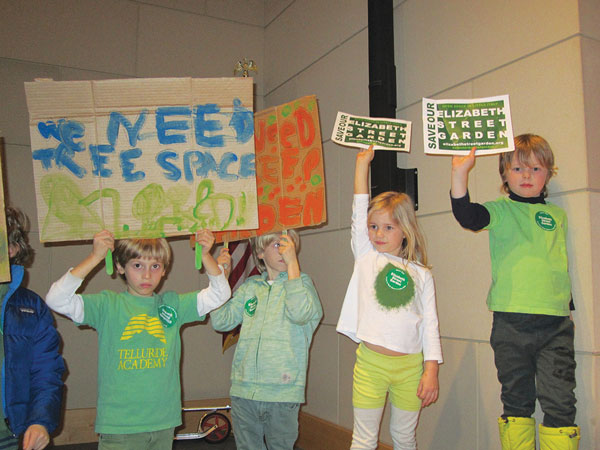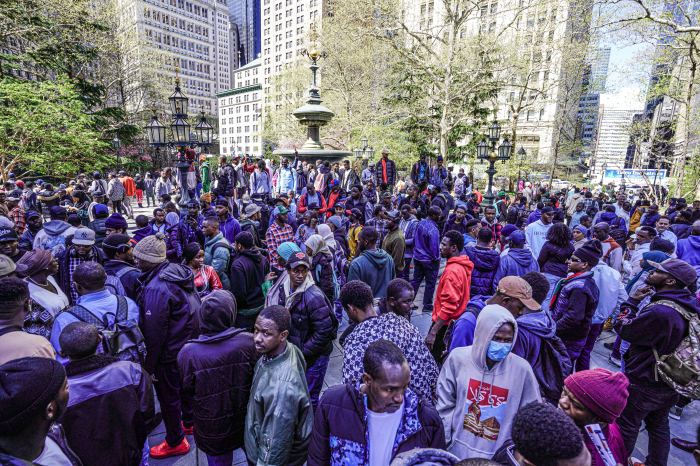
Young Elizabeth St. Garden activists made their point clear at the C.B. 2 meeting, hoisting their signs up in the front of the auditorium, right next to where the community board officers were seated on stage.
BY LINCOLN ANDERSON | Agreeing with about 150 passionate, green-T-shirt-wearing adults and kids who filled the auditorium at last month’s full board meeting, Community Board 2 voted to recommend preserving the Elizabeth St. Garden as permanent public, open green space.
The city’s Department of Housing Preservation and Development is considering the site — a 20,000-square-foot, through lot from Elizabeth to Mott Sts. between Spring and Prince Sts. — as a spot for an affordable-housing development with 60 or 70 units. The garden was identified as a site to provide more affordable housing in connection with the Seward Park Urban Renewal Area project, located on the Lower East Side at the foot of the Williamsburg Bridge.
But neighbors who turned out in force at C.B. 2’s January full-board meeting protested that the neighborhood barely has any open space left and that the garden, which is now regularly open to the public, has become a genuine community resource. Neighbors are in the process of setting up a 501c3 nonprofit to run the open space.
Among those testifying in favor of preserving the garden was Sharon D’Lugoff, one of the daughters of legendary Village Gate impresario Art D’Lugoff. She received a round of applause from the audience after her name was announced before she took the microphone. She noted she lived on Elizabeth St. for 30 years and has witnessed the neighborhood — which she calls Little Italy, not Nolita — radically transform over the years.
“I’ve raised three kids here,” she said. “Two grew up and moved away — they can’t afford to live here.”
Nevertheless, she doesn’t support affordable housing on the Elizabeth St. Garden.
“There are many sites that can be converted, and I truly believe that we can preserve open space and have affordable housing,” she said.
But K Webster, a member of the M’Finda Kalunga Garden in Sara D. Roosevelt Park, spoke in favor of affordable housing.
“I guess you could just look around the room to see we could use more diversity — racial and economic,” she said of the overwhelmingly white crowd. “We can’t pretend there are more sites to build affordable housing — they’re not.
Webster invited people to come enjoy her own garden, located just two blocks away from the Elizabeth St. Garden.
However, architect Steve Wanta, a 30-year Soho resident, lamented the neighborhood’s loss of all its undeveloped spaces and parking lots “where kids would have snowball fights and pickup games. These are all gone,” he said.
After the public testimony and before voting on the issue, C.B. 2 members first debated it among themselves.
“Nolita is ultra-wealthy now,” stated Daniel Ballen, saying he supported “putting a roof over 70 people’s heads.”
Susanna Aaron also came down on the side of constructing affordable housing on the garden.
“Whether the people in that building come from Little Italy or West Harlem,” she said, “we all benefit from the diversity.”
Robin Goldberg, though, noting she is a 36-year Little Italy community member, said the area is starved for quality open space for families.
“DeSalvio Playground is generally ridden with drug addicts and homeless people and other people that play cards and checkers and that have nothing to do with kids,” she said. “I don’t consider the Liz Christy Garden or the Sara Roosevelt — which is essentially a traffic strip — to be a park.”
Added Richard Stewart, “We are a community board and we should be listening to the voices around this park.”
Another board member noted, “This is the southeast corner of the district; it’s not what it’s like if you live near Hudson River Park.”
Maria Passannante-Derr said that the recent Hudson Square rezoning includes a provision for “inclusionary housing,” which would allow developers to build higher if they include affordable housing in their projects. Other members said another potential development site, the St. John’s Center, across from Pier 40, could be somewhere affordable housing is created.
The board then voted on the resolution by its Land Use Committee, chaired by Tobi Bergman. That detailed resolution noted that in the mid-1970s, P.S. 21 was demolished on the site, and in 1981, part of the site was sold to LIRA Apartments Co. for the construction of 152 units of Section 8 affordable housing, now known as 21 Spring St. That agreement called for development and maintenance by LIRA of a public “recreation area” on the remaining portion of the former school site, which remained city-owned; but for unknown reasons this never occurred and the lot became derelict.
In 1991, the open space was leased on a month-to-month basis to Allan Reiver for use by his Elizabeth Street Gallery. Reiver cleaned up the then-crack-infested lot, planted it with trees and shrubs and set out his artifacts and monuments in it — some for sale, some for permanent display — also leasing the space out for private events.
In June 2013, the C.B. 2 committee’s resolution further noted, neighbors, upon learning that the site was city-owned land, worked with Reiver to open up the garden to the public on a daily basis from noon to 6 p.m. The local group subsequently organized free community events in the garden, including movie nights, poetry readings, children’s art programs, the planting of 2,000 daffodil bulbs and a “Harvest Festival” attended by 1,500 people.
The resolution ultimately urges the city to transfer jurisdiction of the lot to the Parks Department; supports the efforts of the Elizabeth St. Garden volunteers to form a nonprofit group to improve the garden and provide programming and community events; and also commits C.B. 2 to “an ongoing and strategic and activist effort, alongside our elected officials and government agencies, to expand and preserve affordable housing in the district.”
The board approved the resolution overwhelmingly by a vote of 30 “Yes” to 2 “No.”
City Councilmember Margaret Chin originally supported the idea of using the Elizabeth St. Garden site as a spot for more affordable housing as a part of the SPURA plan. The SPURA site will have 50 percent affordable housing, but some advocates had pushed for 100 percent affordable housing, and Chin has said she was disappointed she couldn’t get more affordable housing on the actual SPURA site.
Asked her thoughts on the board’s vote, Chin said, “I fully support Community Board’s 2 commitment to develop more affordable housing in our neighborhood. In today’s difficult economy, it is more important than ever to create housing opportunities for working families. The site on Elizabeth St. is an ideal place to start; it is one of the largest publicly owned, undeveloped sites in Community Board 2, and also offers the potential for a significant open-space component that everyone can enjoy. I thank everyone who has participated in community discussions for the best uses of the site, and I look forward to continuing the dialogue and exploring these possibilities with residents and neighborhood stakeholders. Together, we can work toward a plan that reflects both affordable housing and open-space priorities.”
Meanwhile, Land Use Committee chairperson Bergman and David Gruber, C.B. 2 chairperson, stood firmly behind the board’s resolution on the garden.
“The response in the community to the idea of using this site for housing was huge and almost unanimous in opposition, but the proposal served as a wakeup call,” Bergman said. “Our resolution also strengthened our commitment to preserving and expanding affordable housing, which is as important to protecting the true character of our neighborhoods as preserving our historic districts and buildings.”
Added Gruber, “We need to do more for affordable housing, but we can’t give up our precious open space. Our district is at the extreme bottom of community boards in terms of parks and open space. I’ve appointed a task force of board members to work with H.P.D. and our elected officials as well as housing experts to develop a strategic and activist approach to assure we will be doing everything we need to do to hold onto the thousands of affordable apartments we have, and to encourage and work toward creation of new permanently affordable units.
“This month,” Gruber said, “I expect the board will approve a project that will build 25 new affordable apartments in Hudson Square, the first new affordable units to be built in our district in many years.”
Bergman said that project is on Clarkson St.
The H.P.D. proposal for the Elizabeth St. Garden isn’t even in the ULURP stage yet, Bergman noted, referring to the city’s seven-month-long Uniform Land Use Review Procedure, which would be required for such a project. Under ULURP, C.B. 2 would again have a chance to weigh in on the proposal. But first, H.P.D. would have to issue a request for proposals, or R.F.P., from developers for the site. If H.P.D. picked a developer, that developer would have to do the necessary environmental reviews and the ULURP.
“As far as I know, H.P.D. is not working on an R.F.P. at this time,” Bergman said, “and of course given the C.B. 2 position, I hope they will not.”
















